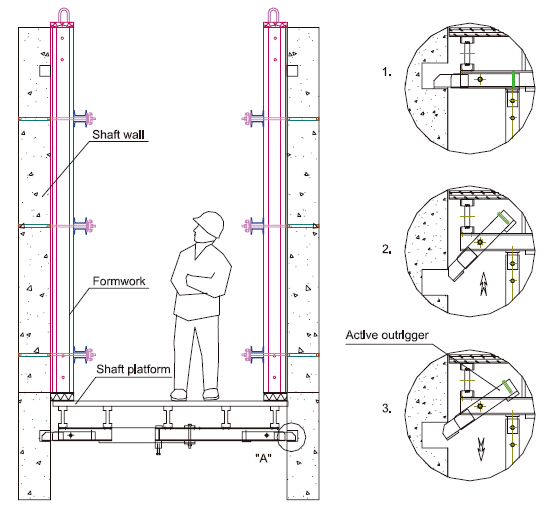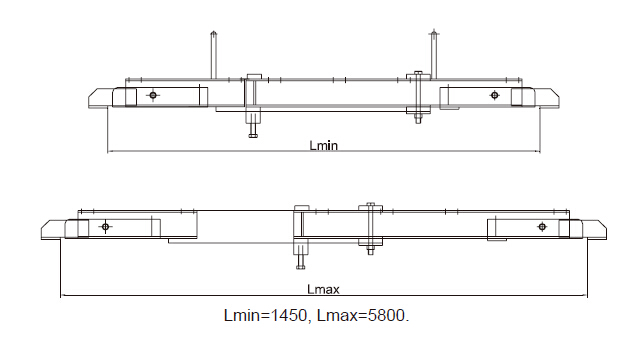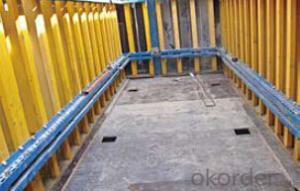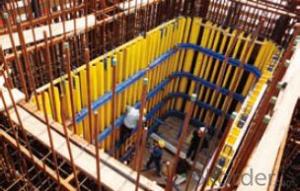Shaft platform S40 System for Formwork and Scaffolding
- Loading Port:
- Tianjin
- Payment Terms:
- TT OR LC
- Min Order Qty:
- 50 m²
- Supply Capability:
- 1000 m²/month
OKorder Service Pledge
Quality Product, Order Online Tracking, Timely Delivery
OKorder Financial Service
Credit Rating, Credit Services, Credit Purchasing
You Might Also Like
Shaft Platform
As operating platform, the shaft platform is mainly used in the concrete pouring of elevator shaft,
equipment shaft, stair shaft of high-rise building and so on.
Characteristics:
◆ The length of shaft beam is adjustable.
◆ Flexible structure makes lifting easier.


- Q:What are the common safety precautions when working with steel formwork?
- When working with steel formwork, there are several common safety precautions that should be followed to ensure the safety of workers and prevent accidents. These precautions include: 1. Proper training: All workers involved in using steel formwork should receive proper training on its assembly, disassembly, and use. This training should cover all safety procedures and precautions. 2. Personal protective equipment (PPE): Workers should always wear appropriate PPE, including safety helmets, safety glasses, hearing protection, gloves, and steel-toed boots. This will protect them from potential hazards such as falling objects, flying debris, and sharp edges. 3. Inspection of formwork: Before starting any work, the steel formwork should be inspected for any defects, damage, or wear. Any damaged or faulty components should be repaired or replaced immediately to ensure structural integrity and prevent accidents. 4. Secure footing: Workers should always have a secure footing when working with steel formwork. This can be achieved by using proper scaffolding, ladders, or working platforms. Additionally, any slippery surfaces should be addressed by using non-slip materials or applying anti-slip coatings. 5. Fall protection: Adequate fall protection measures should be in place, especially when working at heights. This can include using guardrails, safety nets, or personal fall arrest systems (PFAS) to prevent falls and protect workers in case of an accident. 6. Communication and coordination: Effective communication and coordination between workers is crucial when working with steel formwork. Clear communication of tasks, instructions, and potential hazards can help prevent accidents and ensure a safe working environment. 7. Proper lifting techniques: When handling heavy steel formwork components, workers should use proper lifting techniques to avoid strains, sprains, or other injuries. This includes lifting with the legs and not the back, using mechanical lifting aids when necessary, and seeking assistance for heavy or awkward loads. 8. Fire safety: Steel formwork can be a fire hazard, so it is important to have fire prevention measures in place. This includes ensuring adequate fire extinguishers are available, maintaining clear access to fire exits, and having a designated fire assembly point. By following these common safety precautions, workers can minimize the risk of accidents and injuries when working with steel formwork. It is essential for all workers and supervisors to prioritize safety and remain vigilant throughout the entire construction process.
- Q:How does steel formwork affect the overall aesthetics of a construction project?
- The overall aesthetics of a construction project can be significantly influenced by steel formwork. Unlike traditional timber formwork, steel formwork offers a modern and sleek look that enhances the visual appeal of a structure. The clean lines and smooth surfaces achieved with steel formwork give a building a polished and sophisticated appearance. Moreover, steel formwork allows for greater precision and accuracy in shaping concrete, resulting in a more seamless and uniform finish. This is particularly important in architectural designs that require intricate or complex shapes. By using steel formwork, the concrete is poured exactly as intended, resulting in a more visually appealing end result. Furthermore, steel formwork is highly durable and resistant to wear and tear. It does not warp or deform over time, maintaining its structural integrity and aesthetic appeal for a longer period. This durability contributes to the longevity and overall quality of a construction project, making it a more attractive investment for owners and potential buyers. Another advantage of steel formwork is its adaptability. Steel can be easily molded and shaped into various sizes and configurations, allowing for greater design flexibility. This versatility empowers architects and designers to create unique and eye-catching structures that stand out from the rest. In conclusion, the use of steel formwork in a construction project has a positive impact on its overall aesthetics. Its sleek appearance, precise shaping capabilities, durability, and design flexibility all contribute to a visually appealing end result. Steel formwork enhances the architectural design, creates a polished finish, and increases the longevity and value of the structure.
- Q:Can steel formwork be used for office building construction projects?
- Office building construction projects can indeed utilize steel formwork. This option, known for its versatility and durability in concrete construction, presents numerous advantages. With its exceptional strength and stability, steel formwork can withstand the pressures and loads encountered throughout the construction process. Furthermore, its reusability renders it a cost-effective choice for extensive undertakings such as office buildings. Moreover, the assembly and disassembly of steel formwork are effortless, facilitating swift and efficient construction and enabling faster turnaround times. Overall, steel formwork stands as a fitting choice for office building construction projects due to its robustness, longevity, cost-effectiveness, and efficiency.
- Q:Can steel formwork be used for both new construction and renovation projects?
- Yes, steel formwork can be used for both new construction and renovation projects. Steel formwork is highly versatile and can be easily adapted to fit various project requirements. It provides excellent strength and durability, making it suitable for both small and large-scale projects. Steel formwork can be used for constructing new structures as well as for renovating existing ones. It offers the advantage of being reusable, reducing costs and waste in the long run. Additionally, steel formwork allows for precise and accurate construction, ensuring high-quality results in both new construction and renovation projects.
- Q:Can steel formwork be used for both vertical and horizontal structures?
- Yes, steel formwork can be used for both vertical and horizontal structures. Steel formwork is versatile and can be easily assembled and disassembled, making it suitable for various types of construction projects. It provides strength and stability, ensuring that the concrete is properly contained and shaped in both vertical and horizontal applications.
- Q:How are steel formwork systems assembled and disassembled?
- A simple and efficient process is used to assemble and disassemble steel formwork systems. The process begins by erecting the steel panels, which interlock with each other using connecting devices like pins, wedges, or clips. These panels come in various sizes and shapes to meet different construction needs. To assemble the steel formwork system, the panels are aligned and connected based on the desired shape and dimensions of the structure. Pins or wedges are commonly used to secure the panels and prevent movement during concrete pouring. Once the panels are connected, support structures such as walers, props, and braces are installed. Walers are horizontal beams that connect the vertical panels, while props provide additional stability as adjustable vertical supports. Braces help resist lateral forces. During concrete pouring, the steel formwork system holds the wet concrete in place, giving shape and finish to the structure. After the concrete has cured and gained strength, the dismantling process begins. To disassemble the steel formwork system, the props and braces are removed first, followed by the walers. Once the support structures are taken down, the panels can be easily detached by removing the connecting devices. This can be done by pulling out pins or wedges or releasing clips. The disassembly process follows a systematic approach, starting from the top and moving downwards to ensure safety and prevent accidental collapse. It is important to follow safety guidelines and use appropriate tools to avoid damage to the formwork system or injury to workers. In conclusion, steel formwork systems are assembled by connecting panels and installing support structures, while the disassembly process involves removing support structures and disconnecting panels. This systematic approach ensures a safe and efficient construction process, allowing for the reuse of the formwork system in future projects.
- Q:What are the common cost-saving strategies when using steel formwork?
- There exist several commonly employed strategies for cost reduction when utilizing steel formwork in construction projects. 1. Reusability: Steel formwork's ability to be reused multiple times is one of its key advantages. By properly maintaining and storing the formwork after each use, it can be utilized for multiple projects, thereby lessening the need for new formwork and ultimately resulting in cost savings. 2. Durability: Steel formwork is renowned for its durability and long lifespan. It can withstand high pressures and be utilized for an extended duration compared to traditional formwork materials such as timber. This durability decreases the necessity for frequent repairs or replacements, leading to long-term cost savings. 3. Efficiency: Steel formwork facilitates faster and more efficient construction in comparison to traditional formwork methods. The ease of assembly and disassembly, coupled with the use of hydraulic systems, enables swifter construction cycles and reduces labor costs. Furthermore, the precision and accuracy of steel formwork ensure minimal material wastage, further contributing to cost savings. 4. Safety: Steel formwork provides enhanced safety features when compared to other formwork materials. It offers stability and structural integrity, thereby reducing the risk of accidents during the construction process. A safer working environment translates to lower insurance costs and potential legal liabilities, resulting in cost savings. 5. Reduced labor costs: Steel formwork is typically lighter and easier to handle than alternative materials. This diminishes the number of workers required for installation and removal. Additionally, the speed and efficiency of steel formwork result in reduced labor hours, leading to cost savings. 6. Lower maintenance costs: Steel formwork necessitates minimal maintenance when compared to other formwork materials. Regular cleaning and appropriate storage are typically sufficient to maintain its performance. This eliminates the need for expensive maintenance or repairs, resulting in cost savings over time. 7. Improved quality: Steel formwork ensures consistent quality in construction. It provides accurate dimensions and smooth finishes, reducing the need for additional finishing work. This saves both time and money, as there is no requirement for additional materials or labor to rectify imperfections. In conclusion, the employment of steel formwork in construction projects allows for numerous cost-saving strategies, including reusability, durability, efficiency, safety, reduced labor costs, lower maintenance costs, and improved quality. By considering and implementing these strategies, construction projects can optimize their budget and achieve significant cost savings.
- Q:What are the different types of sealing systems used with steel formwork?
- Steel formwork commonly utilizes various sealing systems to ensure the containment of poured concrete and prevent leakage. One commonly used sealing system for steel formwork is the rubber gasket. This involves placing a flexible rubber strip between the formwork panels' joints, which creates a watertight seal when the panels are locked together. This sealing system is particularly useful in situations where preventing water seepage through the formwork joints is necessary. Another sealing system used with steel formwork is the mechanical seal. This method involves tightening metal clips or clamps to generate a pressure seal between the formwork panels. Mechanical seals are highly effective in preventing leakage and are capable of withstanding high pressures, making them ideal for applications that require a strong and secure seal. In addition, adhesive-based sealing systems are also utilized with steel formwork. These systems involve applying adhesive tapes or sealants to the joints of the formwork panels, creating a bond that effectively seals any gaps or openings. This type of sealing system is often chosen for its quick and easy sealing solution. Ultimately, the selection of a sealing system for steel formwork depends on the specific project requirements. Factors such as desired water resistance, pressure levels, and project time constraints all influence the most suitable sealing system choice.
- Q:How does steel formwork affect the overall construction site dust control?
- Steel formwork can have a positive impact on overall construction site dust control. Compared to other types of formwork, such as wooden or plastic, steel formwork is more durable and less likely to wear down or break, which can generate dust particles. This means that there will be less dust generated during the construction process. Additionally, steel formwork is typically designed to fit tightly together, reducing the gaps and spaces where dust can accumulate. This results in a cleaner and more controlled construction site environment, as there will be fewer areas for dust to settle and become airborne. Furthermore, steel formwork can be reused multiple times, which reduces the need for frequent replacements. This minimizes the amount of waste generated, including dust-producing debris from formwork removal and replacement. Overall, the use of steel formwork contributes to better dust control on construction sites, promoting a safer and healthier work environment for workers and reducing the potential negative impacts of dust on nearby communities and the environment.
- Q:What are the considerations when selecting the appropriate formwork system for a project?
- When selecting the appropriate formwork system for a project, there are several considerations that need to be taken into account. These considerations include the type of structure being constructed, the required finish of the concrete, the project timeline, the budget, and the available resources. The type of structure being constructed is a crucial factor in selecting the formwork system. Different structures, such as walls, columns, or slabs, require different types of formwork systems to ensure proper support and stability. It is important to understand the specific requirements of the structure before choosing a formwork system. The required finish of the concrete also plays a role in selecting the appropriate formwork system. If a smooth and seamless finish is desired, a formwork system that can provide the necessary level of detail and precision must be chosen. On the other hand, if a rough finish is acceptable, a simpler and less expensive formwork system may be sufficient. The project timeline is another key consideration. Some formwork systems are quicker and easier to assemble and dismantle, which can help speed up the construction process. Additionally, the availability of the formwork system and the lead time required for procurement should also be considered to ensure that it aligns with the project schedule. Budget is always an important consideration in any construction project. Formwork systems vary in cost, and it is essential to select a system that fits within the project's budget. It is also important to consider the long-term cost implications, such as maintenance and reusability, to determine the overall cost-effectiveness of the chosen formwork system. Lastly, the available resources, including labor and equipment, should be taken into account when selecting a formwork system. Some systems may require specialized labor or equipment, which may not be readily available or may require additional costs. Considering the resources at hand will help determine the feasibility and practicality of a particular formwork system. In conclusion, selecting the appropriate formwork system for a project requires careful consideration of the type of structure, required concrete finish, project timeline, budget, and available resources. By evaluating these factors, project managers can make informed decisions that will contribute to the successful completion of the project.
1. Manufacturer Overview |
|
|---|---|
| Location | |
| Year Established | |
| Annual Output Value | |
| Main Markets | |
| Company Certifications | |
2. Manufacturer Certificates |
|
|---|---|
| a) Certification Name | |
| Range | |
| Reference | |
| Validity Period | |
3. Manufacturer Capability |
|
|---|---|
| a)Trade Capacity | |
| Nearest Port | |
| Export Percentage | |
| No.of Employees in Trade Department | |
| Language Spoken: | |
| b)Factory Information | |
| Factory Size: | |
| No. of Production Lines | |
| Contract Manufacturing | |
| Product Price Range | |
Send your message to us
Shaft platform S40 System for Formwork and Scaffolding
- Loading Port:
- Tianjin
- Payment Terms:
- TT OR LC
- Min Order Qty:
- 50 m²
- Supply Capability:
- 1000 m²/month
OKorder Service Pledge
Quality Product, Order Online Tracking, Timely Delivery
OKorder Financial Service
Credit Rating, Credit Services, Credit Purchasing
Similar products
New products
Hot products
Related keywords

























